2020 Triumph Rocket 3 R and Rocket 3 GT Review – First Ride
We have (keyless) igntion, aaannd lift-off...
Well, you always want more, don’t you? That’s how Triumph Chief Engineer Stuart Wood justifies the world’s biggest-engined production motorcycle, and that’s what the new Rocket 3 wants to deliver. From the 2294 cubic centimeters of the original Rocket to 2458 cc, now there are three 4.3-inch pistons producing a claimed 163 lb-ft. of torque and 167 horses at 6000 rpm, and that’s what it’s all about.
2020 Triumph Rocket 3 R and GT
| Engine | 18.5/20 |
| Suspension/Handling | 13.5/15 |
| Transmission/Clutch | 9.0/10 |
| Brakes | 9.5/10 |
| Instruments/Controls | 4.75/5 |
| Ergonomics/Comfort | 9.5/10 |
| Appearance/Quality | 9.5/10 |
| Desirability | 9.5/10 |
| Value | 9.0/10 |
| Overall Score | 92.75/100 |
2020 Triumph Rocket 3 R and GT First Look
2020 Triumph Rocket 3 TFC First Look
Also more lightness; Triumph says the new Rocket’s 88 pounds lighter than the outgoing model. It definitely looks way more svelte than the old bike, and the new seamless gas tank doesn’t hurt in the looks department. Neither do the brushed alloy intake and hydroformed exhaust header balancing the left and right sides of that big engine, totally reminiscent of a Supermarine Spitfire, or any of the other tasteful upscale touches.
Get the Flash Player to see this player.
Frankly the power claims seem somewhat exaggerated as we rocket along a few long straights leading to the top of Tenerife’s volcano; either that or the lowish-revving Rocket’s just sneaky fast. Rolling power all the way on in the lower gears definitely brings on rapid acceleration, but not quite the kind that tunnels your vision and makes you involuntarily roll back out of it like I expected. Reducing Triumph’s claim 11% to convert from crankshaft to rear-tire torque (it’s a shaft final drive), we should have 145 pound-feet. My butt dyno puts it at maybe 135-ish. We’ll just have to wait and see when we get our hands on a test unit ASAP, and I’ll humbly apologize as needed.
Not that it matters unless you’re planning on taking your Rocket to the track, really. On the road, there’s always more than enough juice. From 2.5 liters, I guess I expected it to start flowing at 2000 rpm or less, but it’s really not till 2500 that the big engine starts getting serious. It’ll pull cleanly from 1500 rpm, but it feels like you’re lugging it. By 3000 rpm you need to be holding on tight, and from 5000 to the 6500-rpm redline, you really are compressing scenery. Triumph claims 165 horses at 6000 rpm; I’m going to estimate 145 at the rear tire.
The quality of the power is what it’s all about. Long-legged like a fine touring car, we’re serving up 74 mph at around 3200 rpm. That’s like 23 mph for each 1k rpm. Set the standard cruise control and enjoy the relaxed, soles forward ride on the GT. The R’s lower bar might be a bit aggressive for long days, but then that’s totally dependent on how fast you “tour.”
When you hit the curves, you can either overstimulate the excellent new spline-cut six-speed gearbox and ride like a maniac, or just leave it in a higher gear and roll the throttle off and on: Plan B may be quicker – but maybe not if you spring for the optional up/down quickshifter. The old Rocket’s sheer size made it look like a cartoon version of itself. The new bike is still big, but doesn’t look or feel as intimidating as the old one; 88 pounds is a huge weight loss. Triumph says the new R weighs 642 pounds dry, and we’re also 0.7 inches shorter of wheelbase at 66 inches.
Chief Engineer Wood, who was of course hanging right with the group, is proud of Triumph’s in-house fuel-injection programming, ahh, program, and as usual the Rocket’s fueling seems spot-on even in Euro 5 trim. In fact, he says it wasn’t even that tough to exceed Euro 5. What you can feel if you’re intent on being critical is a smidge of drivetrain lash as you’re on and off the gas, but not enough to upset the proceedings.
Triumph seems incapable of building a motorcycle that doesn’t also handle really well, and the Rocket got the usual treatment in development. A huge 47mm fully-adjustable inverted fork carries the gigantic front tire, and a fully adjustable Showa shock with a manual preload adjuster is tucked just out of sight under the left sidecover. Putting a 240-section tire on back always makes for unique handling, but the front custom-built Avon’s well-matched to the rear, and restores normal service to the Triumph’s curvy road manners. For being so large, the Rocket goes around corners very well. Drag that 300mm rear disc to tighten your line, and please be careful not to let the pavement yank your heel off the footpeg followed by the rest of your leg. Ouch. I’m still hobbling.
That happened to me on the GT, with its forward footpegs and higher handlebar, in a right-hand corner, and to a fellow journalist’s left leg in a left. Most of us preferred the R’s midset pegs for sporty riding, and felt like if the R had the GT’s higher handlebar it would be just about perfect. Luckily, those pieces are swappable between R and GT.
Faced with the need to control that much power and weight, the Rocket’s Showa suspension components may not be Triumph’s best effort at bump absorption. Serial bumps can start filtering through to the editorial fundament, and braking hard over bumps sometimes has the fork bouncy enough to make you overshoot where you wanted to turn. Possibly a simple matter of taking the time to twist an adjuster or two, but modern motojournalism is more concerned with photo- and videography.
Naturally they moved the Rocket into the 21st century while they were at it, with a new Inertial Measurement Unit developed with Continental controlling the lean-sensitive ABS and traction control systems, both of which get their directions from whichever mode you select: Rain, Road, Sport, or the customizable Rider. Mode selection also affects power delivery. Sport really does prod the world’s biggest production engine along, and knowing the safety systems are standing watch only encourages you to flog the big Rocket harder than you should. What could go wrong? The other side of Tenerife was chilly and damp, and those rider aids are reassuring things to have when riding expensive, borrowed motorcycles. Probably even more if you own it. Shudder the thought…
The brakes being aided by the IMU are as upscale as everything else, the latest in Brembo Stylema calipers up front, which, in combination with the fat contact patch on the front Avon, really can stand the Rocket on its nose.
For just cruising along on the straight and narrow, the Rocket should prove sublime. The GT comes with a 29.5-inch high touring saddle and forward footpegs with three possible fore-and-aft adjustments, each an inch apart. The R’s mid-mount pegs adjust up and down between two locations 15mm apart. Another downside with the forward pegs is that they put your right ankle in close approximation to the exhaust pipe; even on a cool day on the volcano, I could feel a little bit of the big engine’s hot magma through my Aerostich and a pair of jeans. Again, footpegs are swappable between R and GT. As long as you’re going big, I’d suggest R pegs and optional quickshifter.
Aside from that, I see no reason why you shouldn’t be able to opt for the optional saddlebags and spend many happy moons touring to your heart’s content. That, or just sitting there eyeballing all the beautiful detail work Triumph’s put in here: the brushed aluminium this and that, the internally wired handlebars, the hand-painted stripes on the GT’s seamless fuel tank…
Natch, there are already over 50 accessories. I might go for the “Highway Inspiration” kit, which includes: Luggage rack, Sports panniers and mount kit, Triumph Shift Assist and Triumph TFT Connectivity System (the part that Bluetooths up your phone).
There it is. Go big or go home. Things change, alliances and power shifts. While the impeachment drama was playing out back in DC, the President of China was leaving the Tenerife Abama Ritz-Carlton the day we arrived under tight security, and Putin had been lurking on the island at the same time: Putin on the Ritz, Morgan Gales observed, and we sang the Young Frankenstein tune from then forward. I saw zero about any of it in the US press. Probably just a coincidence?
If bigger really is better, and I’m still not convinced, it makes you wonder why Triumph, only back in business since the ’90s, has the balls to build a bike like this and none of the other superpowers have ever bothered to climb out of the big V-Twin rut? I don’t know that they can get much bigger than 2000 cc?
Dunno, but those bug eye headlights (lighting is now full LED) take us right back to the original Speed Triple and the real beginning of modern Triumph’s audacious success. Seeing those eyeballs on the Rocket 3 is like seeing a good old trouble-maker friend decades later. Same face but a bit pudgier, same twinkle in the eye, same thumb in the eyeball of authority but now better manicured. This new Rocket 3, to me, almost feels more like a mature Speed Triple than it does the old Rocket, and that is in no way a bad thing. Triumph strikes again.
2020 Triumph Rocket 3
+ Highs
- Seamless fuel tank and top-shelf detailing throughout
- So torquey, so comfy…
- 88 pounds less makes it way more manageable than the previous version
– Sighs
- I expected more whump at 2500 rpm from 2500 ceecees
- 32 mpg is not much better than Ryan Adams’ sport-touring Tuono
- Careful with your heels when you’re cornering on the GT
In Gear
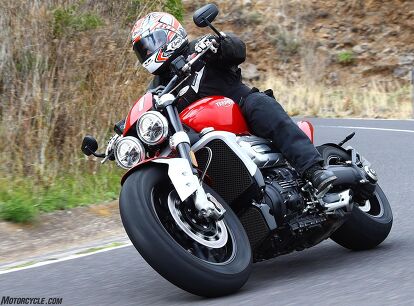
Helmet: Arai Corsair X Hayden Laguna Seca $881 yikes!
- Suit: Aerostich Roadcrafter $1,337
- Gloves: Discontinued
Boots: Sidi Arcadia Tex $179
Specifications | 2020 Triumph Rocket 3 R | 2020 Triumph Rocket 3 GT |
|---|---|---|
| MSRP | $21,900 | $22,600 |
| Engine Type | Inline 3-cylinder, water-cooled, DOHC | |
| Capacity | 2458cc | |
| Bore/Stroke | 110.2 mm x 85.9 mm | |
| Maximum Power | 165 hp at 6000rpm | |
| Maximum Torque | 163 lb-ft. at 4000rpm | |
| Fuel system | Ride-by-wire, fuel injected | |
| Exhaust | Stainless 3-into-1 headers with 3 exit silencer / CAT box | |
| Final drive | Shaft, bevel box | |
| Clutch | Hydraulic, torque-assist | |
| Gearbox | 6 speed | |
| Frame | Full aluminium frame | |
| Instruments | TFT multi-functional instrument pack with digital speedometer, trip computer, digital tachometer, gear position indicator, fuel gauge, service indicator, ambient temperature, clock and rider modes (Rain/Road/Sport/Rider-configurable) – Triumph TFT Connectivity System can be added with accessory fitted Bluetooth module | |
| Swingarm | Single-sided, cast aluminium | |
| Front Wheel | 17 x 3.5in cast aluminium | |
| Rear Wheel | 16 x 7.5in cast aluminium | |
| Front Tyre | 150/80 R17 V | |
| Rear Tyre | 240/50 R16 V | |
| Front Suspension | Showa 47mm upside-down 1+1 cartridge front forks, compression and rebound adjuster. 120mm travel | |
| Rear Suspension | Fully adjustable Showa piggyback reservoir RSU with remote hydraulic preload adjuster, 107mm rear wheel travel. | |
| Front Brake | Dual 320mm discs, Brembo M4.30 Stylema 4-piston radial monobloc calipers, cornering ABS | |
| Rear Brake | Single 300mm disc, Brembo M4.32 4-piston monobloc caliper, cornering ABS | |
| Seat Height | 30.4 inches | 29.5 inches |
| Rake | 27.9° | |
| Trail | 5.3 inches | |
| Dry Weight | 642 pounds (claimed) | 648 pounds (claimed) |
| Fuel Tank Capacity | 4.75 gallons | |
| Fuel Consumption | 32.43 mpg (claimed) | |
| CO2 Emissions | EURO 5 Standard: 158g/km | |
We are committed to finding, researching, and recommending the best products. We earn commissions from purchases you make using the retail links in our product reviews. Learn more about how this works.
More by John Burns



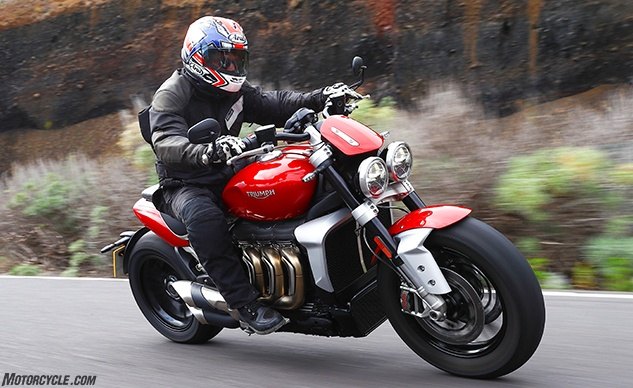



















































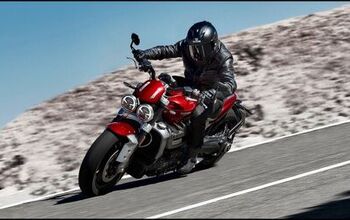




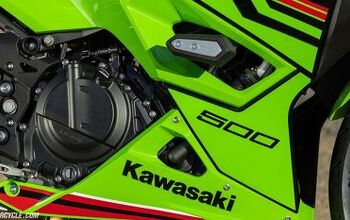
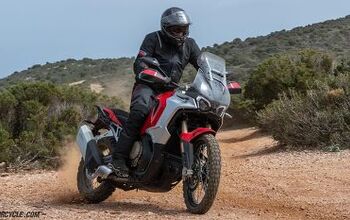










Comments
Join the conversation
If Duesenberg made a motorcycle today.
Triumph's attempt to build a giant motorcycle ... I bet it eats rear tires like candy.